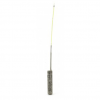Archival Tag
 Data storage or archival tags have been used extensively to study large-scale movement and behavioral patterns of marine fish, reptiles, birds and mammals. In the past 5 years, rapid advances in archival tag technology (smaller size, increased memory capacity and lower cost) have made it possible to gather information on a wide variety of open ocean animals. The main premise of using an archival tag is that the researcher has to retrieve the tagged animal in order to get the data back.
Data storage or archival tags have been used extensively to study large-scale movement and behavioral patterns of marine fish, reptiles, birds and mammals. In the past 5 years, rapid advances in archival tag technology (smaller size, increased memory capacity and lower cost) have made it possible to gather information on a wide variety of open ocean animals. The main premise of using an archival tag is that the researcher has to retrieve the tagged animal in order to get the data back.
Archival tags are small in size (5-20 grams) and are most often implanted or secured externally on the animal, where they record a variety of parameters. Archival tags record pressure, ambient light, internal body temperature and external water temperature. For mammals, reptiles and birds, these same data can be collected in addition to heart rate and swimming velocity. The measurement of environmental light levels are used to estimate latitude and longitude (see Geolocating Archival Tag). Archival tags have the capacity to record these various parameters, at a programmed rate (e.g., every 1 to 2 minutes), over periods of deployment ranging from a few days to ten years. This level of data intensity allows scientists to determine an animal’s fine and large-scale behavioral patterns, migratory routes and physiology, all in relation to the surrounding environment.
One remarkable feature of the archival tags is they allow the researcher to build a picture of the behavior of the animal in the context of its ocean environment. The tags record high-resolution environmental data as well as behavioral data and this permits the archival-tagged animals to serve as platforms that obtain data on the physical properties of the oceans. Software permits displaying the physical structure of the water column and the movements and behavior of the animals in the context of their environment.
The only limitation of archival tags is that they must be recovered to obtain the recorded data. This limitation restricts their use to animals such as fish and sharks that have a sufficiently large fishery associated with them to ensure their eventual capture and return; or animals such as seabirds, sea turtles and marine mammals, that return to rookeries with high fidelity.
